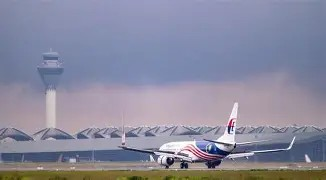Ransomware Attack on Kuala Lumpur International Airport Shuts Down Key Systems
Published on: 08 Jul 2025

In early 2024, Kuala Lumpur International Airport (KLIA), one of Southeast Asia’s busiest aviation hubs, experienced a severe ransomware attack that disrupted airport operations for several days. The attack targeted critical IT systems, including flight information displays, baggage handling, and administrative networks, forcing delays and cancellations.
The ransomware strain used was identified as Conti, a notorious gang known for high-profile, coordinated attacks on public infrastructure and businesses worldwide.
⚠️ How the Attack Unfolded
Investigations revealed that attackers gained initial access via a phishing email targeting airport staff, leading to the compromise of a workstation. From there, the Conti ransomware spread rapidly through the internal network, exploiting unpatched vulnerabilities and weak segmentation between critical systems.
Key vulnerabilities included:
Lack of network segmentation allowing ransomware to reach operational systems
Insufficient email filtering and security awareness among employees
Delayed application of critical software patches
Once deployed, Conti encrypted a wide range of data, forcing KLIA’s IT team to shut down affected systems to contain the spread, which led to a partial halt in flight processing and passenger services.
💡 Response and Recovery Efforts
KLIA’s cybersecurity and IT teams, alongside government cybersecurity agencies, worked round the clock to:
Isolate infected systems and prevent further spread
Use backups to restore critical data and services
Engage external incident response experts for forensic analysis
Communicate proactively with airlines, passengers, and media to manage the crisis
Though operations resumed after several days, the incident caused a significant backlog and raised concerns about the airport’s cybersecurity posture.
📉 Business and Public Impact
The attack had immediate consequences:
Over 200 flights delayed or cancelled in the first 72 hours
Passenger inconvenience and loss of traveler confidence
Financial losses from operational disruption and emergency response costs
Increased scrutiny from regulatory bodies and airport stakeholders
The incident underlined the rising threat of ransomware to critical infrastructure and highlighted the need for proactive cybersecurity investments in the aviation sector.
🛡️ Lessons Learned
KLIA’s ransomware incident offers vital cybersecurity lessons for all critical infrastructure operators:
Implement Strong Network Segmentation
Separate IT systems from operational technology (OT) to limit ransomware spread.
Enhance Email Security and Training
Continuous phishing simulation exercises and advanced filtering are essential.
Timely Patch Management
Regular updates and vulnerability scanning prevent exploit chains.
Maintain Reliable and Isolated Backups
Backups must be secured and regularly tested for restoration efficacy.
Incident Response Preparedness
Predefined response plans and drills improve reaction time and coordination.
🔒 Conclusion
The KLIA ransomware attack was a wake-up call for airports and other critical infrastructure worldwide. As cyber threats evolve, resilience requires not only technology upgrades but also continuous employee training, incident readiness, and collaboration with government agencies. Investing in these areas protects not just operational continuity but also public safety and trust.
The ransomware strain used was identified as Conti, a notorious gang known for high-profile, coordinated attacks on public infrastructure and businesses worldwide.
⚠️ How the Attack Unfolded
Investigations revealed that attackers gained initial access via a phishing email targeting airport staff, leading to the compromise of a workstation. From there, the Conti ransomware spread rapidly through the internal network, exploiting unpatched vulnerabilities and weak segmentation between critical systems.
Key vulnerabilities included:
Lack of network segmentation allowing ransomware to reach operational systems
Insufficient email filtering and security awareness among employees
Delayed application of critical software patches
Once deployed, Conti encrypted a wide range of data, forcing KLIA’s IT team to shut down affected systems to contain the spread, which led to a partial halt in flight processing and passenger services.
💡 Response and Recovery Efforts
KLIA’s cybersecurity and IT teams, alongside government cybersecurity agencies, worked round the clock to:
Isolate infected systems and prevent further spread
Use backups to restore critical data and services
Engage external incident response experts for forensic analysis
Communicate proactively with airlines, passengers, and media to manage the crisis
Though operations resumed after several days, the incident caused a significant backlog and raised concerns about the airport’s cybersecurity posture.
📉 Business and Public Impact
The attack had immediate consequences:
Over 200 flights delayed or cancelled in the first 72 hours
Passenger inconvenience and loss of traveler confidence
Financial losses from operational disruption and emergency response costs
Increased scrutiny from regulatory bodies and airport stakeholders
The incident underlined the rising threat of ransomware to critical infrastructure and highlighted the need for proactive cybersecurity investments in the aviation sector.
🛡️ Lessons Learned
KLIA’s ransomware incident offers vital cybersecurity lessons for all critical infrastructure operators:
Implement Strong Network Segmentation
Separate IT systems from operational technology (OT) to limit ransomware spread.
Enhance Email Security and Training
Continuous phishing simulation exercises and advanced filtering are essential.
Timely Patch Management
Regular updates and vulnerability scanning prevent exploit chains.
Maintain Reliable and Isolated Backups
Backups must be secured and regularly tested for restoration efficacy.
Incident Response Preparedness
Predefined response plans and drills improve reaction time and coordination.
🔒 Conclusion
The KLIA ransomware attack was a wake-up call for airports and other critical infrastructure worldwide. As cyber threats evolve, resilience requires not only technology upgrades but also continuous employee training, incident readiness, and collaboration with government agencies. Investing in these areas protects not just operational continuity but also public safety and trust.



